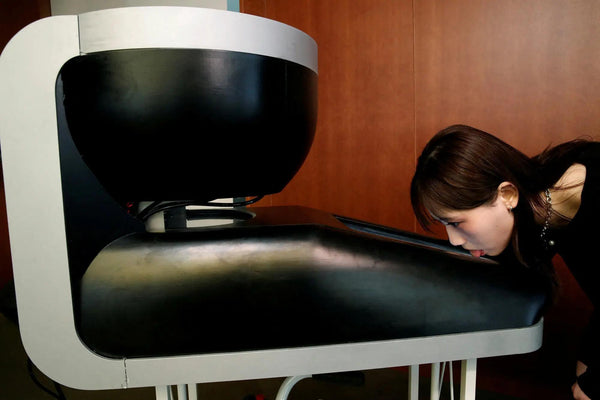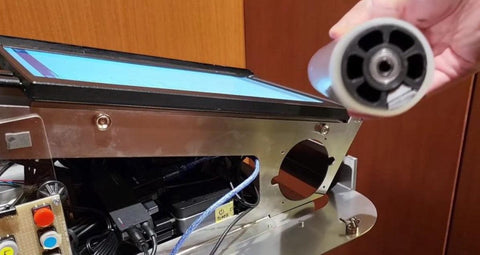TTTV - A Lickable TV Screen Invented by Japanese Professor

Jump to:
With the rapid development of IT-related technology, people can purchase and consume what they want to eat no matter where they live nowadays. You can make purchases at e-commerce websites, or directly order at shops or restaurants by using online food delivery services. Once you place the order, you just need to wait until the items reach you. When considering the fact that these services were technically and physically impossible several decades ago, these technological advances are truly awesome.
However, have you ever thought of a situation where you could experience the taste of food at any moment regardless of the type of restaurant and its location? In other words, would it not be fantastic if you could enjoy restaurant dishes that are not near you immediately at home? Although it is difficult to realize this service with the current level of technology, there is one device that can be an important milestone in achieving this desire.
One Japanese professor has invented a prototype TV screen that allows you to experience the taste of food by licking the screen. This machine is termed “Taste the TV”, which is usually abbreviated to TTTV. In this blog post, we will explore this innovative device in depth.
What is TTTV?
Taste the TV (hereafter referred to as TTTV) allows you to see, hear, and most importantly, taste the contents. When the food is displayed on the screen, you can also sense its flavor by licking it. Strictly speaking, however, it is not the screen itself but a liquid that has the relevant flavor (we will discuss this further later). Although methods of food production are different, the TTTV is somewhat close to a gadget in the Doraemon series called “Gourmet Table Cloth” because both share similarities with each other in terms of providing requested foods immediately.

Who invented the TTTV?
It was Homei Miyashita, a professor in the School of Interdisciplinary Mathematical Sciences (a faculty of science and technology) at Meiji University, who made the TTTV. An expert in human-computer interactions, he is passionate about research on how to expand human expression to digital content. In his words, expression also includes things beyond human behavior including CG, games, music, and even tweets.

The TTTV is not Miyashita’s only tasting invention. Another fancy and creative device he made is a pair of chopsticks that allows the user to enhance a sensation of saltiness without adding salt. There is an electric cord on one of the chopsticks, which extends to a small device on a wristband. This device produces an imperceptible electrical current to stimulate the user’s salty taste sensation by 50%. As a result, people who use these chopsticks can experience saltiness to a greater extent than usual while reducing their salt intake.

Other inventions Miyashita made include a glove that can adjust the taste sensation and a mask-type display that can recreate the taste of food. He specializes in developing flavor-related devices with a touch of AR technology.
What made Professor Miyashita develop the TTTV?
What were the driving forces behind the production of the TTTV? According to Miyashita, there are three motivations that led to this licking TV screen:
To enlarge the opportunities of eating-out
The outbreak of COVID-19 restricted people’s access to eating outside the home. Some restaurants, bars, and pubs shortened their opening hours for infection prevention, so people have more difficulty going out to eat even if they are safe and healthy.
In contrast, the TTTV can imitate the taste of almost anything, so you can experience the taste of particular dishes without visiting the facilities in question. It is not a mere TV screen, but rather a machine that offers you the simulation experience of eating out.
To entertain people through diet
Miyashita argues that although the original roles of diet are to satisfy hunger as well as to achieve nutritional balance, it also has aspects of entertainment. He also added that the TTTV has the potential to meet people’s needs of diet as a means to satisfy themselves mentally.
To provide an experience in which people can eat anything from anywhere
It is not always easy to visit restaurants that are far from where you live. Meanwhile, it may also be difficult to appreciate dishes from high-class restaurants on a regular basis even if they are near you.
TTTV can resolve these issues; it can recreate the taste made by professionals as long as its data is created. Miyashita mentions that the TTTV makes it possible for users to have the experience of eating at restaurants overseas while staying at home.
How does the TTTV work?
In this section, you can learn more about the mechanism of the TTTV. Its taste-production processes can be briefly categorized as the following: data creation, data input to TTTV, liquid production, and licking.
First, it is necessary to analyze and create the data digitally with the help of a taste sensor that measures the intensity of taste including five basic tastes (saltiness, sweetness, sourness, bitterness, and umami). To do so, you need to agitate foods and turn them into a solution. After this step, the sensor measures its taste composition to create numeric data. This data will be input to the TTTV as “taste content”. If you do not have the taste sensor and related equipment, do not worry; Miyashita is planning to sell these items as a product in the future. If this idea is put to practical use, even people who cannot create data by themselves will have access to the data.

When the data is ready to use, you need to upload it to the TTTV’s system. This device has built-in flavor canisters that will create the taste liquid based on the data. There are 10 canisters in the device and each one contains liquids of different tastes such as five basic tastes, pungency, astringency, alcohol, and more. There are sprays attached to each canister, and they create the taste of a particular food by blending liquids on a film. Once this liquid combination process is completed, it rolls over the screen in front of you, and finally, it is ready to lick!

The film scrolls when you finish licking, so the other users will not lick the same film as you. Furthermore, this film is exchangeable, so you do not have to be overconcerned about hygiene. However, if you are reluctant to lick the screen (or film), you can place a plate on the area where sprays are generated, and lick the plate. You can also place some pieces of plain crackers on the spraying area, and eat them instead of licking the liquid.

Other applications
Along with its original function, the TTTV can offer a variety of applications. This machine can be used as a learning material for sommeliers and cooks by offering them tasting quizzes. In addition, its slot machine game recreates the taste according to picture designs; for instance, if all three reels have a cherry picture, the TTTV creates cherry-flavored liquid as a reward.
There is even a video-chat function where you can enjoy a virtual dinner with people on the screen. Surprisingly, when a companion on the screen outputs the taste data to the TTTV, you can also taste what that person has created. TTTV offers communication opportunities that allow you to share your culinary experience with the person on the screen as if you were enjoying an online drinking party.
0 comments